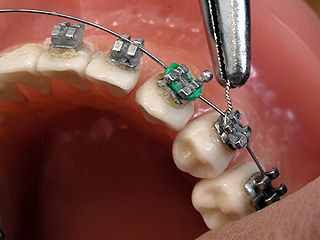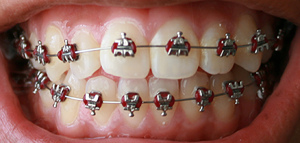Related Research Articles

Orthodontics is a dentistry specialty that addresses the diagnosis, prevention, management, and correction of mal-positioned teeth and jaws, and misaligned bite patterns. It may also address the modification of facial growth, known as dentofacial orthopedics.

Dental braces are devices used in orthodontics that align and straighten teeth and help position them with regard to a person's bite, while also aiming to improve dental health. They are often used to correct underbites, as well as malocclusions, overbites, open bites, gaps, deep bites, cross bites, crooked teeth, and various other flaws of the teeth and jaw. Braces can be either cosmetic or structural. Dental braces are often used in conjunction with other orthodontic appliances to help widen the palate or jaws and to otherwise assist in shaping the teeth and jaws.

In orthodontics, a malocclusion is a misalignment or incorrect relation between the teeth of the upper and lower dental arches when they approach each other as the jaws close. The English-language term dates from 1864; Edward Angle (1855-1930), the "father of modern orthodontics", popularised it. The word "malocclusion" derives from occlusion, and refers to the manner in which opposing teeth meet.

An archwire in orthodontics is a wire conforming to the alveolar or dental arch that can be used with dental braces as a source of force in correcting irregularities in the position of the teeth. An archwire can also be used to maintain existing dental positions; in this case it has a retentive purpose.

A palatal expander is a device in the field of orthodontics which is used to widen the upper jaw (maxilla) so that the bottom and upper teeth will fit together better. This is a common orthodontic procedure. Although the use of an expander is most common in children and adolescents 8–18 years of age, it can also be used in adults, although expansion is slightly more uncomfortable and takes longer. A patient who would rather not wait several months for the end result by a palatal expander may be able to opt for a surgical separation of the maxilla. Use of a palatal expander is most often followed by braces to then straighten the teeth.
Orthodontic technology is a specialty of dental technology that is concerned with the design and fabrication of dental appliances for the treatment of malocclusions, which may be a result of tooth irregularity, disproportionate jaw relationships, or both.
Self-ligating brackets are defined as "a dental brace, which generally utilizes a permanently installed, moveable component to entrap the archwire". Self-ligating brackets have also been designed which do not require a movable component to hold the wire in place. Self-ligating braces may be classified into two categories: Passive and Active.
Percival Raymond Begg AO was a professor at the University of Adelaide School of Dentistry and a well known orthodontist, famous for developing the "Begg technique". Permanent displays dedicated to the Begg technique can be found in the Smithsonian Institution in Washington DC, the Library of the American Dental Association in Chicago, and the PR Begg Museum at the University of Adelaide.
Pre-eruption guidance is an orthodontic treatment method that allows for expansion of existing erupting teeth long before they appear in the mouth. The use off pre-eruption guidance appliances and the timing of extractions of certain deciduous teeth aligns the teeth naturally as opposed to orthodontic mechanical movement of permanent teeth into alignment after they have erupted. Research shows that pre-eruption guidance produces far more stable tooth alignment than alternative treatments.
Lingual braces are one of the many types of the fixed orthodontic treatment appliances available to patients needing orthodontics. They involve attaching the orthodontic brackets on the inner sides of the teeth. The main advantage of lingual braces is their near invisibility compared to the standard braces, which are attached on the buccal (cheek) sides of the tooth. Lingual braces were invented by Craven Kurz in 1976.
Charles J. Burstone was an American orthodontist who was notable for his contributions to biomechanics and force-systems in the field of orthodontics. He was well known for co-development of new orthodontic material such as beta titanium, nickel titanium, and long fiber-reinforced composite. He wrote more than 200 articles in scientific fields.
Calvin Suveril Case was an American orthodontist who is known to be one of the earliest prominent figures in Orthodontics. Case did extensive work with cleft lip and palate and is known to develop Velum Obturator. Case is known for his part in the Extraction Debate of 1911 that happened between Edward Angle and Case.

Anchorage in orthodontics is defined as a way of resisting movement of a tooth or number of teeth by using different techniques. Anchorage is an important consideration in the field of orthodontics as this is a concept that is used frequently when correcting malocclusions. Unplanned or unwanted tooth movement can have dire consequences in a treatment plan, and therefore using anchorage stop a certain tooth movement becomes important. Anchorage can be used from many different sources such as teeth, bone, implants or extra-orally.
A lip bumper is a dental appliance used in orthodontics, for various purposes to correct a dentition by preventing the pressure from the soft tissue. Lip bumpers are usually used in orthodontic treatment where the patient has a crowded maxillary or mandibular teeth in an arch.
Elastics are rubber bands frequently used in the field of orthodontics to correct different types of malocclusions. The elastic wear is prescribed by an orthodontist or a dentist in an orthodontic treatment. The longevity of the elastic wear may vary from two weeks to several months. The elastic wear can be worn from 12 to 23 hours a day, either during the night or throughout the day depending on the requirements for each malocclusion. The many different types of elastics may produce different forces on teeth. Therefore, using elastics with specific forces is critical in achieving a good orthodontic occlusion.
Activator Appliance is an Orthodontics appliance that was developed by Viggo Andresen in 1908. This was one of the first functional appliances that was developed to correct functional jaw in the early 1900s. Activator appliance became the universal appliance that was used widely throughout Europe in the earlier part of the 20th century.
Open bite is a type of orthodontic malocclusion which has been estimated to occur in 0.6% of the people in the United States. This type of malocclusion has no vertical overlap or contact between the anterior incisors. The term "open bite" was coined by Carevelli in 1842.
Anthony Gianelly (1936–2009) was an American orthodontist. He developed the bi-dimensional technique, which is widely used in various private practices of orthodontics and has been the subject of numerous publications over the years.
Orthodontic indices are one of the tools that are available for orthodontists to grade and assess malocclusion. Orthodontic indices can be useful for an epidemiologist to analyse prevalence and severity of malocclusion in any population.
Georgia School of Orthodontics (GSO) is an orthodontic school located in Atlanta, Georgia, United States. It was established in 2016 and offers a 36 month Advanced Specialty Education Program in Orthodontics & Dentofacial Orthopedics. In response to GSO's growth, the school opened another location in Georgia in 2017.
References
- ↑ Songra, Goldie; Clover, Matthew; Atack, Nikki E.; Ewings, Paul; Sherriff, Martyn; Sandy, Jonathan R.; Ireland, Anthony J. (2014). "Comparative assessment of alignment efficiency and space closure of active and passive self-ligating vs conventional appliances in adolescents: A single-center randomized controlled trial". American Journal of Orthodontics and Dentofacial Orthopedics. 145 (5): 569–78. doi:10.1016/j.ajodo.2013.12.024. PMID 24785921.
- ↑ Chen, Stephanie Shih-Hsuan; Greenlee, Geoffrey Michael; Kim, Jihyun-Elizabeth; Smith, Craig L.; Huang, Greg J. (2010). "Systematic review of self-ligating brackets". American Journal of Orthodontics and Dentofacial Orthopedics. 137 (6): 726.e1–726.e18, discussion 726–7. doi:10.1016/j.ajodo.2009.11.009. PMID 20685517.
- ↑ Pandis, Nikolaos; Fleming, Padhraig S.; Spineli, Loukia M.; Salanti, Georgia (2014). "Initial orthodontic alignment effectiveness with self-ligating and conventional appliances: A network meta-analysis in practice". American Journal of Orthodontics and Dentofacial Orthopedics. 145 (4): S152–63. doi: 10.1016/j.ajodo.2013.12.016 . PMID 24680024.